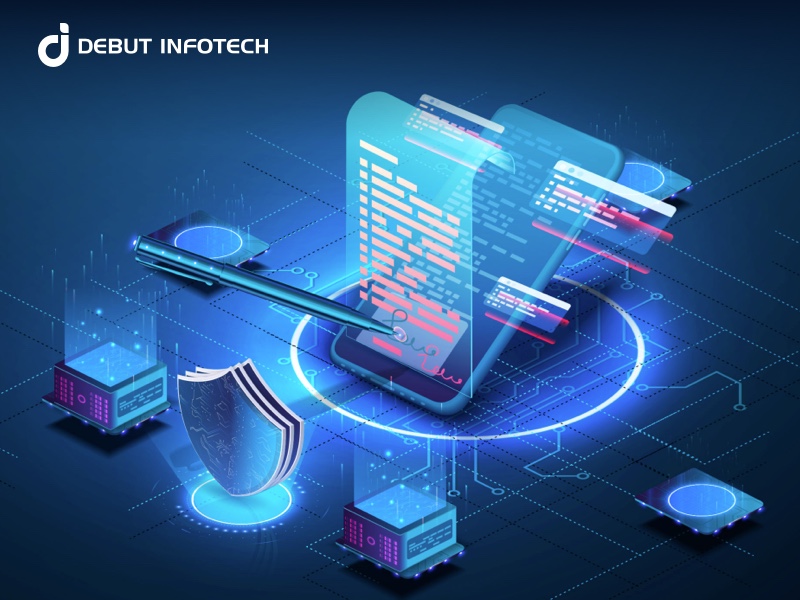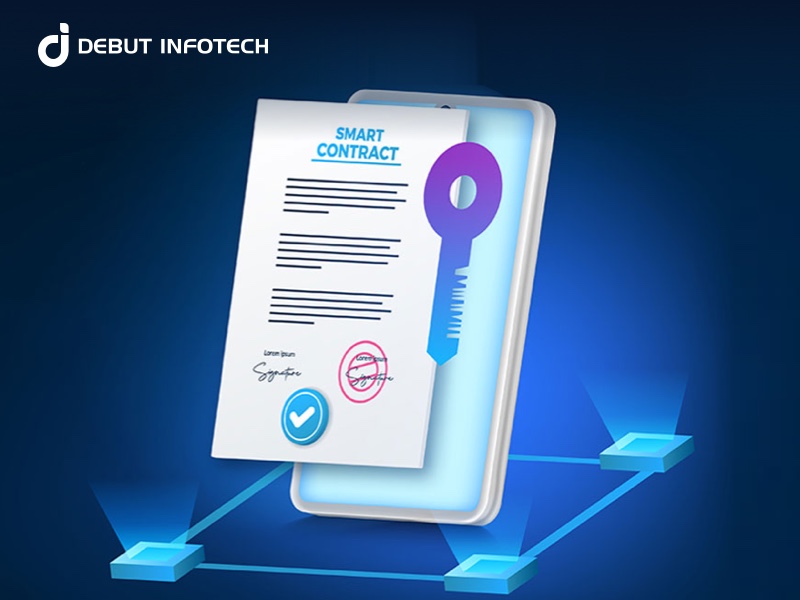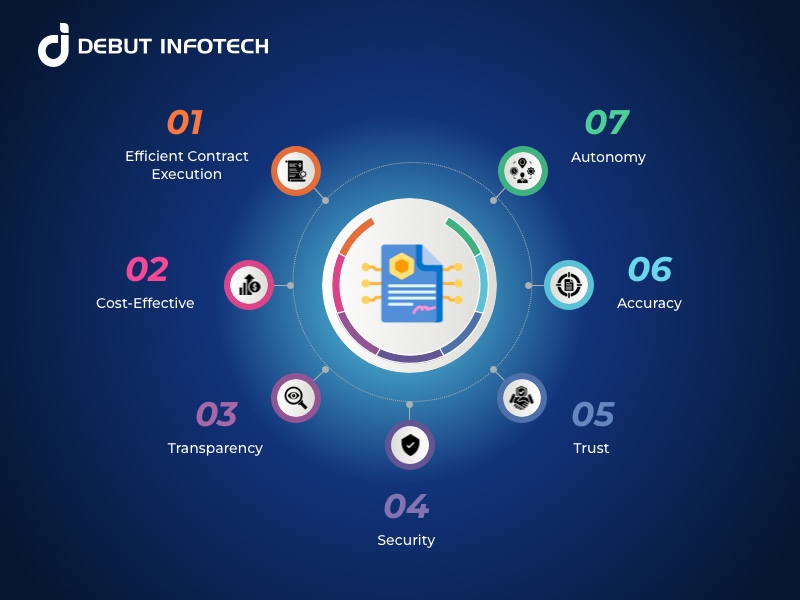Business
Building the Future: How Smart Contracts Fuel Next-Gen Blockchain Apps?

Smart contracts streamline business processes by eliminating intermediaries, ensuring security, and enhancing efficiency. Read how this revolutionary technology transforms industries and drives next-gen blockchain apps in our detailed blog.
Don’t you get frustrated when contracts are too slow or prone to mistakes, which can hinder complicated business transactions? Imagine contracts that are executed automatically. They eliminate intermediaries while streamlining business processes.
The power of smart contracts is self-enforcing software that automates critical functions within blockchain apps. Crypto investors and blockchain firms must understand the power of smart contracts to empower new-generation apps. This article explains how smart contract technology is revolutionizing the blockchain industry, enabling a new era of efficiency, innovation, and trust.
In this write-up, we will explore how traditional contracts evolved, their features, use cases, benefits of smart contract development services, and more. Let’s get started.
The Evolution Journey of Smart Contracts on Blockchain
Nick Szabo, a cryptographer, was the one who first introduced the idea of smart contracts in the 1990s. Since their inception, smart contracts have undergone significant development. Szabo anticipated a computer program that would allow contractual clauses to be incorporated into software and would then automatically enforce the terms. On the other hand, the implementation of blockchain technology was the catalyst that made smart contracts a practical possibility.
Ethereum then made history with its launch in 2015 which further introduced Ethereum smart contracts. It allowed developers access to its decentralized environment where smart contracts could be created and deployed using the Solidity programming language. Further, this innovation expanded blockchain beyond cryptocurrency applications & laid the foundation for today’s decentralized applications (dApps).
From 2021-2024, smart contracts have made significant advances with the launch of layer 2 solutions such as Polygon. It has the capability to enhance scalability while decreasing costs. AI integration into executing smart contracts also enabled more adaptive contract functionalities to emerge. Regulatory frameworks increasingly accommodate these solutions for legal compliance as well as wider adoption across various industries.
Importance of Smart Contracts in Decentralized Systems
Trust is at the core of decentralized systems and smart contracts enable automation without intermediary involvement to avoid increased costs and delays associated with traditional contracts. Thus, eliminates the need for intermediary agents such as lawyers or banks as enforcement points for terms. Instead, smart contracts provide for contract execution that doesn’t depend on any one party trusting another – eliminating delays caused by dependence.

Smart contracts ensure the integrity of transactions in decentralized systems by protecting them against fraud or manipulation. This is because they are immutable and transparent when deployed on blockchain technology. Their trustless nature makes smart contracts highly important in various sectors like finance, supply chain management, real estate, etc., where security plays a significant role.
How Do Smart Contracts Work in Blockchain Development?
Smart contracts are self-executing agreements that are written directly into code. Also, they function on blockchain networks to execute when certain conditions are met, ensuring automation, accuracy, and trustlessness in transactions. Here’s how they work in blockchain development:
- Coding the Contract: Developers begin the smart contract creation process by writing it using the programming language associated with their chosen blockchain (Ethereum typically uses Solidity). This code contains all conditions and rules required for the execution of the agreement.
- Deployment: Once a smart contract has been created and coded, it needs to be placed onto the blockchain for deployment. This involves creating a transaction that contains its compiled code; once mined and recorded on the blockchain, this transaction gives its unique address for tracking purposes.
- Triggering Events: Smart contracts sit idly on the blockchain, waiting for specific events that trigger them to activate. These could include anything from passing of time or receiving funds, to specific transactions on the blockchain.
- Execution: When certain conditions are fulfilled, smart contracts automatically execute themselves. For instance, crowdfunding campaigns might use smart contracts that transfer funds once a certain funding threshold has been met by its deadline.
- Verification and Record: Every action taken by a smart contract is recorded on the blockchain to ensure its immutability and transparency. Network nodes verify these actions using consensus mechanisms like proof of work or proof of stake, depending on which blockchain it uses.
Automating this process removes intermediaries, reduces error risk, and ensures contract terms are carried out as anticipated.
Key Features Of Smart Contracts That Are Essential For Blockchain Development
Smart contracts comprise several essential components that enable them to function effectively within blockchain networks. Understanding these components is crucial for developers and businesses alike:
- Contract Address: Each smart contract deployed on a blockchain is assigned a unique address, similar to an account number. This address is used to interact with the contract, send transactions, and trigger its functions.
- Application Binary Interface (ABI): The ABI defines how to interact with the smart contract’s functions and data. It acts as an interface between the contract’s bytecode and the external environment, specifying the methods that can be called and the data types involved.
- State Variables: These are storage variables within the smart contract that hold the contract’s data. For instance, in a smart contract for a token, state variables would store the token balances of different addresses.
- Functions: Functions are blocks of code within the smart contract that perform specific tasks. They can be public (accessible by anyone) or private (accessible only within the contract). Functions can modify state variables, execute transactions, and trigger events.
- Modifiers: The purpose of modifiers is to change the behavior of functions. They can be used to impose conditions on function execution, such as ensuring that only the contract owner can execute a particular function.
- Events: Events are a way for smart contracts to communicate with the external world. They log significant actions taken by the contract, such as a transfer of tokens. These logs can be monitored by off-chain applications to trigger further actions.
These components work together to create a robust, transparent, and secure environment for executing smart contracts on the blockchain.
Benefits of Smart Contracts in Blockchain Development

Smart contracts bring numerous advantages that make them essential in developing blockchains:
Efficient Contract Execution
Smart contracts automate agreement execution by eliminating intermediary services like lawyers or notaries from transactions, speeding up operations while cutting transaction times down significantly.
Cost-Effective
By eliminating intermediaries and decreasing manual intervention requirements, smart contracts significantly lower transaction costs – particularly beneficial in industries with large transaction volumes.
Transparency
Once deployed on the blockchain, smart contract terms become clear and unchangeable for all parties involved to see, building trust among participants while decreasing disputes between them.
Security
Smart contracts take advantage of blockchain’s cryptographic security features to be highly protected and unalterable once deployed – this guarantees the terms of any agreement are kept secure and cannot be changed once in place.
Trust
Smart contracts’ trustless nature ensures that parties do not depend on each other or on any central authority to enforce terms as agreed, offering assurance for all concerned. The code behind each smart contract ensures execution as written – offering peace of mind to everyone involved.
Accuracy
Automated execution reduces human errors by guaranteeing contracts are executed as planned – something especially crucial for complex transactions where precision is critical.
Autonomy
Once deployed, smart contracts operate independently from their participants and automatically take actions when certain conditions are fulfilled, with no further input necessary from those involved in their execution.
Use Cases of Smart Contracts
Smart contracts have found applications across a wide range of industries, demonstrating their versatility and transformative potential:
- Finance: In decentralized finance (DeFi), smart contracts enable various financial services like lending, borrowing, and trading without intermediaries. Platforms like Aave and Compound use smart contracts to facilitate peer-to-peer lending and borrowing, providing transparency and security.
- Supply Chain Management: Smart contracts enhance transparency and traceability in supply chains. They can automatically trigger payments and update records when goods reach specific milestones. For example, IBM’s Food Trust blockchain uses smart contracts to track the journey of food products from farm to table.
- Real Estate: Smart contracts streamline real estate transactions by automating processes like property transfers and rental agreements. This reduces paperwork, speeds up transactions, and ensures accuracy. Propy, a blockchain real estate platform, uses smart contracts to handle property transactions efficiently.
- Healthcare: In healthcare, smart contracts manage patient records, ensuring data privacy and security. They facilitate the sharing of medical data between providers while maintaining patient consent. Projects like MedRec use blockchain and smart contracts to enhance the management of medical records.
- Voting Systems: Smart contracts ensure secure and transparent voting processes. They can automate vote counting and provide immutable records, reducing the risk of fraud. Blockchain-based voting platforms like Voatz use smart contracts to enhance the integrity of elections.
- Gaming: In the gaming industry, smart contracts manage in-game assets and transactions. They enable the creation of decentralized gaming platforms where players have true ownership of their digital assets. Projects like Axie Infinity use smart contracts to manage the game’s economy and player transactions.
- Insurance: Smart contracts automate insurance claims and payouts, reducing processing times and eliminating fraud. For instance, Etherisc uses smart contracts to create decentralized insurance applications that handle claims transparently and efficiently.
These diverse use cases highlight the potential of smart contracts to transform various industries by enhancing efficiency, security, and transparency.
Final Words
Smart contracts have emerged as an indispensable element of custom blockchain app development, offering unsurpassed efficiency, security, and transparency. As blockchain technology develops further, these contracts will take an ever-increasing role in changing various industries – spanning finance, to healthcare, and more.
Business owners and investors can contact Debut Infotech – a leading smart contract and blockchain development company offering smart contract development services, to harness the power of smart contracts to drive innovation and create more robust, decentralized systems. The future of blockchain development is bright, and smart contracts are at the heart of this technological revolution.
SEE ALSO: Boeing Unveils Manufacturing Quality and Safety Improvement Plan

Business
PepsiCo Reduces Revenue Projections As North American Snacks And Key International Markets Underperform.

(VOR News) – In the third quarter of this year, Pepsi’s net income was $2.93 billion, which is equivalent to $2.13 per share. This was attributed to the company.
This is in stark contrast to net income of $3.09 billion, which is equivalent to $2.24 per share, during the same period in the previous year. The company’s earnings per share were $2.31 when expenses were excluded.
Net sales decreased by 0.6%, totaling $23.32 billion. Organic sales increased by 1.3% during the quarter when the effects of acquisitions, divestitures, and currency changes are excluded.
Pepsi’s beverage sales fell this quarter.
The most recent report indicates that the beverage and food sectors of the organization experienced a 2% decline in volume. Consumers of all income levels are demonstrating a change in their purchasing habits, as indicated by CEOs’ statements from the previous quarter.
Pepsi’s entire volume was adversely affected by the lackluster demand they encountered in North America. An increasing number of Americans are becoming more frugal, reducing the number of snacks they ingest, and reducing the number of times they purchase at convenience stores.
Furthermore, Laguarta observed that the increase in sales was partially attributed to the election that occurred in Mexico during the month of June.
The most significant decrease in volume was experienced by Quaker Foods North America, which was 13%. In December, the company announced its initial recall in response to a potential salmonella infection.
Due to the probability of an illness, the recall was extended in January. Pepsi officially closed a plant that was implicated in the recalls in June, despite the fact that manufacturing had already been halted.
Jamie Caulfield, the Chief Financial Officer of Pepsi and Laguarta, has indicated that the recalls are beginning to have a lessening effect.
Frito-Lay experienced a 1.5% decline in volume in North America. The company has been striving to improve the value it offers to consumers and the accessibility of its snack line, which includes SunChips, Cheetos, and Stacy’s pita chips, in the retail establishments where it is sold.
Despite the fact that the category as a whole has slowed down in comparison to the results of previous years, the level of activity within the division is progressively increasing.
Pepsi executives issued a statement in which they stated that “Salty and savory snacks have underperformed year-to-date after outperforming packaged food categories in previous years.”
Pepsi will spend more on Doritos and Tostitos in the fall and winter before football season.
The company is currently promoting incentive packets for Tostitos and Ruffles, which contain twenty percent more chips than the standard package.
Pepsi is expanding its product line in order to more effectively target individuals who are health-conscious. The business announced its intention to acquire Siete Foods for a total of $1.2 billion approximately one week ago. The restaurant serves Mexican-American cuisine, which is typically modified to meet the dietary needs of a diverse clientele.
The beverage segment of Pepsi in North America experienced a three percent decrease in volume. Despite the fact that the demand for energy drinks, such as Pepsi’s Rockstar, has decreased as a result of consumers visiting convenience stores, the sales of well-known brands such as Gatorade and Pepsi have seen an increase throughout the quarter.
Laguarta expressed his opinion to the analysts during the company’s conference call, asserting, “I am of the opinion that it is a component of the economic cycle that we are currently experiencing, and that it will reverse itself in the future, once consumers feel better.”
Additionally, it has been noted that the food and beverage markets of South Asia, the Middle East, Latin America, and Africa have experienced a decline in sales volume. The company cut its forecast for organic revenue for the entire year on Tuesday due to the business’s second consecutive quarter of lower-than-anticipated sales.
The company’s performance during the quarter was adversely affected by the Quaker Foods North America recalls, the decrease in demand in the United States, and the interruptions that occurred in specific international markets, as per the statements made by Chief Executive Officer Ramon Laguarta.
Pepsi has revised its forecast for organic sales in 2024, shifting from a 4% growth rate to a low single-digit growth rate. The company reiterated its expectation that the core constant currency profitability per share will increase by a minimum of 8% in comparison to the previous year.
The company’s shares declined by less than one percent during premarket trading. The following discrepancies between the company’s report and the projections of Wall Street were identified by LSEG in a survey of analysts:
SOURCE: CNBC
SEE ALSO:
Old National Bank And Infosys Broaden Their Strategic Partnership.
Business
Old National Bank And Infosys Broaden Their Strategic Partnership.

(VOR News) – Old National Bank, a commercial bank with its headquarters in the Midwest, and Infosys, a firm that specializes in information technology, have recently entered into a strategic expansion of their link, which has been in place for the past four years.
This expansion is more likely to take place sooner rather than later, with the likelihood being higher.
For the purpose of making it possible for Old National Bank to make use of the services, solutions, and platforms that are offered by Infosys, the objective of this expansion is to make it possible for the bank to transform its operations and processes through the application of automation and GenAI, as well as to change significant business areas.
This lets the bank leverage Infosys’ services, solutions, and platforms.
Old National Bank Chairman and CEO Jim Ryan said, “At Old National, we are committed to creating exceptional experiences for both our customers and our fellow employees.”
This statement is applicable to Old National Bank. Infosys is carefully managing the business process innovations that it is putting us through, putting a strong emphasis on efficiency and value growth throughout the process to ensure that it is carried out efficiently.
This is a routine occurrence throughout the entire operation. Because of Infosys’ dedication to our development and success, we are incredibly appreciative of the assistance they have provided.
Old National has been receiving assistance from Infosys in the process of updating its digital environment since the year 2020, according to the aforementioned company.
Ever since that time, the company has been providing assistance. The provision of this assistance has been accomplished through the utilization of a model that is not only powerful but also capable of functioning on its own power.
Infosys currently ranks Old National thirty-first out of the top thirty US banks.
This ranking is based on the fact that Old National is the nation’s largest banking corporation.
It is estimated that the total value of the company’s assets is approximately fifty-three billion dollars, while the assets that are currently being managed by the organization are valued at thirty billion dollars.
Dennis Gada, the Executive Vice President and Global Head of Banking and Financial Services, stated that “Old National Bank and Infosys possess a robust cultural and strategic alignment in the development, management, and enhancement of enterprise-scale solutions to transform the bank’s operations and facilitate growth.”
This remark referenced the exceptional cultural and strategic synergy between the two organizations. Dennis Gada is the one who asserted this claim. This was articulated explicitly concerning the exceptional cultural congruence and strategy alignment of the two organizations.
We are pleased to announce that the implementation of Infosys Topaz will substantially expedite the transformation of Old National Bank’s business processes and customer service protocols. We are exceedingly enthusiastic about this matter. We are quite thrilled about this specific component of the scenario.
Medium-sized banks operating regionally will continue to benefit from our substantial expertise in the sector, technology, and operations. This specific market segment of Infosys will persist in benefiting from our extensive experience. This phenomenon will enable this market sector to sustain substantial growth and efficiency benefits.
SOURCE: THBL
SEE ALSO:
American Water, The Largest Water Utility In US, Is Targeted By A Cyberattack
States Sue TikTok, Claiming Its Platform Is Addictive And Harms The Mental Health Of Children
Qantas Airways Apologizes After R-Rated Film Reportedly Airs On Every Screen During Flight
Business
American Water, The Largest Water Utility In US, Is Targeted By A Cyberattack

The largest regulated water and wastewater utility company in the United States stated Monday that it had been the target of a cyberattack, forcing the company to halt invoicing to consumers.
American Water, The Largest Water Utility In US, Is Targeted By A Cyberattack
American Water, based in New Jersey and serving over 14 million people in 14 states and 18 military facilities, said it learned of the unauthorized activity on Thursday and quickly took precautions, including shutting down certain systems. The business does not believe the attack had an impact on its facilities or operations and said employees were working “around the clock” to determine the origin and scale of the attack.

According to their website, American Water operates over 500 water and wastewater systems in around 1,700 communities across California, Georgia, Hawaii, Illinois, Indiana, Iowa, Kentucky, Maryland, Missouri, New Jersey, Pennsylvania, Tennessee, Virginia, and West Virginia.
SOURCE | AP
-

 News3 years ago
News3 years agoLet’s Know About Ultra High Net Worth Individual
-
Entertainment2 years ago
Mabelle Prior: The Voice of Hope, Resilience, and Diversity Inspiring Generations
-

 Health4 years ago
Health4 years agoHow Much Ivermectin Should You Take?
-

 Tech2 years ago
Tech2 years agoTop Forex Brokers of 2023: Reviews and Analysis for Successful Trading
-

 Lifestyles3 years ago
Lifestyles3 years agoAries Soulmate Signs
-

 Movies2 years ago
Movies2 years agoWhat Should I Do If Disney Plus Keeps Logging Me Out of TV?
-

 Health3 years ago
Health3 years agoCan I Buy Ivermectin Without A Prescription in the USA?
-

 Learning3 years ago
Learning3 years agoVirtual Numbers: What Are They For?